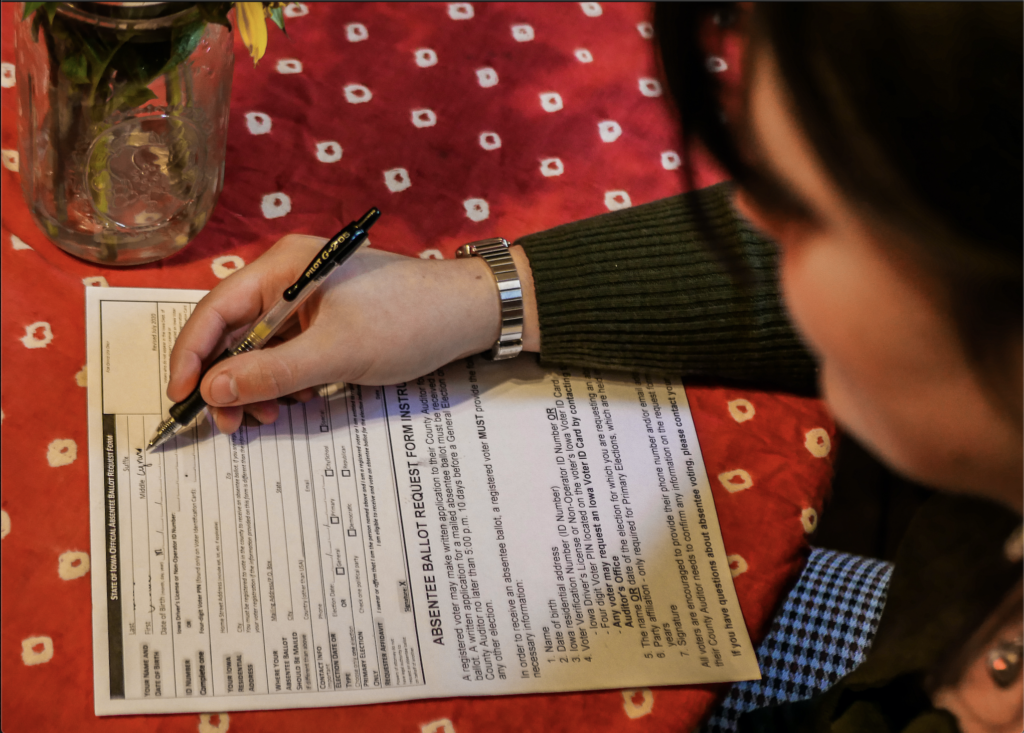Poweshiek County is gearing up for its first general election during the COVID-19 pandemic. Across Iowa, many county officials are worried that increased absentee voting as a result of the pandemic could create logistical hurdles ahead of the November election. Iowa Secretary of State Paul Pate said that he “easily could see 80 percent of the people casting their ballot in the fall election [using] absentee,” during an online webinar on Wednesday.
Despite statewide uncertainty, election officials in Poweshiek County don’t expect to receive a significantly higher number of absentee ballots this election cycle.
“Currently we’re at about 3,500 requests received to date… In 2016, we had 4,700 absentee ballots,” said Missy Eilander, Poweshiek County Auditor. “I think it will probably be pretty comparable, [maybe] more… We have the majority of them already, I would say.”
Absentee ballots can’t be mailed to voters until Oct. 5, but residents of Poweshiek County can still place their order for one. “You’ll need to fill out the absentee request form,” said Eilander, “That gets submitted to our office. We get that and enter it in, and from there we can mail the ballot out.” The absentee ballot request form is available until Oct. 24.
The form itself can be found on both Poweshiek County’s website and the Iowa Secretary of State’s website. You can also call the County Auditor’s office and request one directly. All forms must be printed out and either physically returned or mailed to the Auditor’s office.
To successfully complete the request form, voters must provide their name, birthdate, which election they’re requesting the ballot for and their Poweshiek County address. If a voter’s current residence is outside of Poweshiek County, they can provide a separate mailing address, which can include residencies outside of Iowa.
The form also requires an Iowa driver’s license number, non-operator ID number or the 4-digit pin from a Voter Identification Card. All registered voters in Iowa who don’t have a valid Iowa driver’s license should have received a Voter ID card when they registered to vote.
For Grinnell College students living outside of Iowa, their Voter ID card will be an essential part of requesting a ballot in Poweshiek County. Those who cannot find their Voter ID card can call the Auditor’s office and request a new one.
“If I’m a student from Illinois going to Grinnell College,” said Eilander, “and I register to vote but don’t have an Iowa driver’s license, I’m going to need a Voter Card with a 4-digit pin, because I wouldn’t be in the Iowa [Department of Transportation] system.”
Once the request form is signed and dated, voters mail it back inside of a signed affidavit envelope.
Actual absentee ballots will begin arriving to residencies Oct. 5. No witness is required for the ballot to be completed, and voters can select their candidates and mail the ballot back as soon as they receive it. The Auditor’s office will accept all returned ballots that arrive before Nov. 9, provided they are postmarked before election day (Nov. 3). Any ballot received after Nov. 9, or mailed in after Monday, Nov. 2, will not be counted.
The Auditor’s office will also be open for anyone who wants to physically drop off their absentee ballot. Between Oct. 5 and Nov. 2, any registered voter can stop by the Auditor’s office to receive their absentee ballot and fill it out in-person. This service will also be available on the last two Saturdays leading up to election day.


























































Nancy Baumgartner • Sep 29, 2020 at 9:34 pm
Over the last five decades, I’ve used mail-in voting as much as it was allowed. And, I’ve lived and voted in five different states which all had their own voting procedures. This short article explained more in a succinct manner than any government pamphlet, website or phone call. Thank you, Nick.